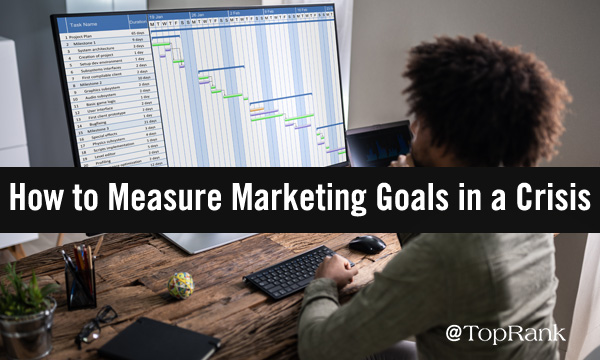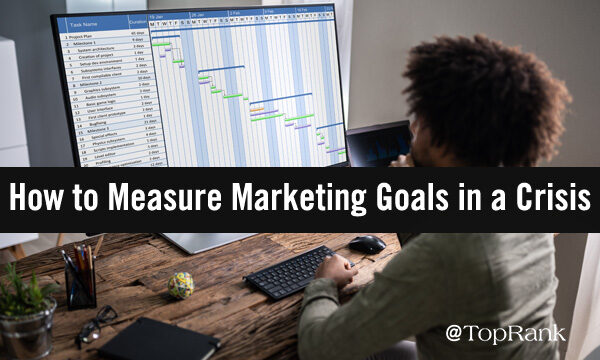
In recent months, I’ve been listening to Paramore’s song “Hard Times” a lot. Their 2017 hit talks about struggling to overcome challenging circumstances above ’80s-inspired new wave pop. It’s a bop, as the kids say, and confronts hardship — truthful and emphatic with a spoonful of sugar.
During this global health crisis, I’m sure most marketers want to wake up fine, be told that they’re alright, and — in their weakest moments — have “wonder[ed] why [we] even try.”
While we have no control over the state of the world, we do have control over how we react or work in tandem with it. With data, we get a glimpse into how our respective markets have been impacted, and it can inform a new perspective and next steps. Let’s take a look at how the pandemic affects data and analytics, and if B2B marketers need to shift their pre-pandemic goals.
Examine Pre- & Post-Crisis Data, Then Decide If Goals Need Updating
This may be the first time in our lifetimes where the whole world is going through the same crisis, but that doesn’t mean that all businesses are being affected in the same way. Some businesses within industries like tech, religious goods, home improvement, and health and fitness are finding themselves in higher demand. Other industries see buyers backing away from the table or putting processes on hold, waiting for more certain times.
Since stay-at-home orders across the U.S. started in early March, we now have enough data to see how this time has impacted shopping and purchasing. We can examine market trends — for example, has search volume around your target keywords changed since March? If so, how? Look at website traffic and revenue data for the last 90 days and compare it to pre-crisis and average or seasonal data. It should be evident whether your business is growing or slowing.
Both camps can benefit from an update in goals. I say “update” rather than “pivot” because sales expectations haven’t disappeared. The journey has just changed.
Businesses that are experiencing increased demand want to become as visible and available to their customers as possible while supplies last, while those with the short end of the stick want to mitigate sales losses and prepare for the end of the crisis. An update to marketing goals may bring changes to strategies, which brings changes to how we measure performance.
“Sales expectations haven’t disappeared. The journey has just changed.” @birdie_zepeda Click To TweetEnsure Your Approach Fits Updated Goals
For Sales-Centric Goals
SEO
As shared in a previous SEO for B2B Marketers post, we are seeing reports that both B2B and B2C brands have seen increases in website traffic, improving 13 percent in March 2020 compared to February, according to HubSpot benchmark data. Buying online is even more popular and many users are using search engines to find online stores.
Consequently, those with sales-centric goals should focus on optimizing landing pages with high conversion rates and that target keywords for the bottom of the sales funnel (i.e. Intent, Purchase, and Customer Loyalty).
Content
Even if growing brand awareness isn’t the primary target of your updated crisis goals, it’s important to update copy to reflect the tone of current times. Customers or clients may not want to partner with someone who isn’t acknowledging that the way of the world has changed, even though it may be temporary.
This allows for the opportunity to ensure high trafficked pages have calls to action that are relevant for visitors that navigate or land there. That way, you can help customers best find what they’re searching for during this time.
Paid Advertisements
Similar to SEO efforts, focusing on search queries or campaigns that are high converters or at the bottom of the funnel can make the most of your ad spend. If possible, consider increasing ad spend where you’re already seeing great returns.
For Branding-Centric Goals
We’re seeing marketers anticipate longer sales cycles by shifting focus from explicit sales to brand awareness for when the crisis begins to settle, so that customers and clients think of your business first when they’re ready to act. For example, just because I can’t travel right now doesn’t mean I’m not dreaming of being on a beach or visiting my family once travel restrictions are lifted!
Content & Influencer Marketing
Content with a distinct voice is at the center of any brand awareness campaign. It supports SEO efforts by creating content for gaps in coverage of top- and middle-of-funnel search queries. It builds credibility and thought leadership when paired with industry leaders and influencers. As audiences become more skeptical of brand marketing and tired of in these uncertain times, we’re here for you ads, unique content can build relationships.
Find your voice and work to make it stand out and provide value to your audience.
SEO
Identifying keywords and optimizing content for the top and middle of the sales funnel (such as: Awareness, Discovery, and Evaluation) supports brand awareness efforts and can help you reach sales goals without coming off as “salesy.” While your customer may not be ready today, you’re proactively helping them make a buying decision.
Paid Advertisements
If you find your budget is smaller, target smarter. Are there geographies that are or aren’t buying? Can your targeting better reflect your converting demographic? Can you focus on keywords or tactics that have a better return on advertising spend (ROAS)?
If you find your budget is unchanged or has even increased, don’t be afraid to try new tactics to gain visibility. This can come in the form of display campaigns, social media promotions, or commercials on digital media platforms.
“Content with a distinct voice is at the center of any brand awareness campaign. It supports SEO efforts by creating content for gaps in coverage of top-and-middle-of-funnel search queries.” @birdie_zepeda Click To TweetMeasurement for New Times (KPIs)
Organic Search & Content Marketing
- increase in impressions
- improvement in ranking/position for target keywords
- increase in organic traffic
- increase in conversions
Paid Advertisements
- improved ROAS
- increased click-through rates (CTR)
- increase in conversions
Social Media or Influencer Marketing
- increase in impressions
- increase in engagement
- likes, shares
- brand mentions in social and earned media
- referral traffic to website from social
Hard Times Feeling Easier?
These hard times are trying, but we hope in covering this topic that times start to feel a bit easier.
If hard times were to be easier with some extra support or guidance, reach out to TopRank Marketing to learn how we can help.



